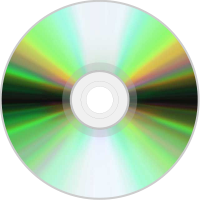- Super Video CD
-
Compact Disc Super Video (SVCD) 

Media type Optical disc Encoding MPEG-2 video + audio Capacity Up to 800 MB Read mechanism 780 nm wavelength semiconductor laser Standard White Book Usage audio and video storage Extended from Video CD Optical discs Optical media types - Blu-ray Disc (BD): BD-R, BD-RE
- DVD: DVD-R, DVD+R, DVD-R DL, DVD+R DL, DVD-R DS, DVD+R DS, DVD-RW, DVD+RW, DVD-RAM, DVD-D, DVD-A, HVD, EcoDisc
- Compact Disc (CD): Red Book, CD-ROM, CD-R, CD-RW, 5.1 Music Disc, SACD, Photo CD, CD Video (CDV), Video CD (VCD), SVCD, CD+G, CD-Text, CD-ROM XA, CD-i
- Universal Media Disc (UMD)
- Enhanced Versatile Disc (EVD)
- Forward Versatile Disc (FVD)
- Holographic Versatile Disc (HVD)
- China Blue High-definition Disc (CBHD)
- HD DVD: HD DVD-R, HD DVD-RW, HD DVD-RAM
- High definition Versatile Multilayer Disc (HD VMD)
- VCDHD
- GD-ROM
- MiniDisc (MD) (Hi-MD)
- Laserdisc (LD) (LD-ROM)
- Video Single Disc (VSD)
- Ultra Density Optical (UDO)
- Stacked Volumetric Optical Disk (SVOD)
- Five dimensional disc (5D DVD)
- Nintendo optical disc (NOD)
Standards - SFF ATAPI/MMC
- Mount Rainier (packet writing)
- Mount Fuji (layer jump recording)
- Rainbow Books
- File systems
See also Super Video CD (Super Video Compact Disc or SVCD) is a digital format for storing video on standard compact discs. SVCD was intended as a successor to Video CD and an alternative to DVD-Video, and falls somewhere between both in terms of technical capability and picture quality. Although SVCDs proved more sophisticated than VCDs, the format ironically remains in the latter's shadow.
Contents
Technical specifications
SVCDs are authored (or "burned") using the CD-ROM mode 2/XA format, allowing roughly 800 megabytes of data to be stored on one 80 minute CD (versus 700 megabytes when using mode 1). One CD can hold up to 35 minutes of full quality SVCD-format video and audio.
Container
In an SVCD, the audio and video streams are multiplexed in a MPEG program stream (MPEG-PS) container.
Video
- Codec: MPEG-2
- Resolution: 2/3 D1
- Aspect Ratio: 4:3
- Framerate:
- Bit rate: Up to 2.6 megabits per second
Because of its 480x480 resolution, SVCD picture quality is more than double that of VCD. On the downside, this increase in picture resolution sacrifices video length capacity by over 50%. Because of this, titles released on SVCD has to come in twice the number of discs of their VCD equivalents. [1]
Unlike other CD-based formats, such as China Video Disc and Video CD, Super Video CD video is incompatible with both the DVD-Video and Blu-ray standards due to a conflict in resolution. However, many DVD and blu-ray players will play back SVCD resolution video from a DVD or blu-ray disk anyway.
Interlaced video is supported for SVCD video, though not required. 23.976 frames per second video is supported by use of interlacing and 3:2 pulldown.
The combined audio and video bit rates should not exceed 2.7 Mbps. This data rate was chosen, in part, to ensure compatibility with slower and less expensive "2 × speed" CD drives.
Audio
- Codec: MPEG-1 Audio Layer II
- Frequency: 44,100 hertz (44.1 kHz)
- Output: Monaural, dual channel, stereo, and multichannel support up to 5.1 output.
- Bit rate: from 32 to 384 kilobits per second, inclusive
As with most compact disc-based video formats, SVCD audio is incompatible with the DVD-Video standard due to the difference in frequency; DVDs require 48 kHz, whereas SVCDs use 44.1 kHz.
SVCDs may have two separate stereo, or four mono audio tracks (for commentary or additional languages).
Audio may have up to 6 channels (in a 5.1 arrangement) using the MPEG Multichannel surround sound format, although space constraints and inconsistent hardware support make it impractical, and very uncommon.
Variable bit rate encoding, while not supported by the MPEG-1 Audio Layer II standard, is part of the SVCD specification. However, variable bit rate audio is not consistently supported by standalone players, and thus the format is rarely used.
Additional features
The SVCD standard supports several other features, including interactive menus, hyperlinks, karaoke lyric highlighting, four selectable overlay graphic subtitle streams, chapters, playlists, and DVD-quality still images/slide shows, along with audio, with a resolution of 704x480 (NTSC) or 704x576 (PAL/SECAM).[2][3]
Playback issues
Presentation of SVCD titles on most players is marred by an unfortunate violation of sampling theory almost built into the specification. The two-thirds choice of resolution is rarely consistently implemented end to end, through the full player electronics. Because a DVD player might include provisions for various VCD, SVCD, and DVD horizontal resolutions (352, 480, or 720) and only one analog low pass filter is provided, 2 out of the 3 formats will suffer aliasing when presented on the screen. Usually, the best resolution—DVD 720—dictates filter design, with SVCD display suffering from "foldover". While displays should follow correct theory, the objectionable aliasing artifacts that result are usually buried in noise from other sources, such as camera, quantization, and MPEG artifacts.
Similar formats
CVD
China Video Disc (CVD) is a CD-based video format which was created during the development of the SVCD standard and is almost identical to SVCD. The primary technical difference is a lower (horizontal) video resolution of 352x480 (NTSC) or 352x576 (PAL/SECAM).[4] Because 352x480/576 is a recognized DVD resolution, CVD video (but not audio) is fully compatible with the DVD-Video standard, and avoids the "foldover" (or aliasing) problems encountered when playing SVCDs on DVD players. The lower resolution also allows the bitrate to be reduced while keeping compression artifacts to a minimum.[5] CVD also supports all of the additional features (selectable subtitles, multiple audio tracks, and so on) which are supported by SVCD.
SVCD players are required to be fully compatible with the CVD standard. However, "SVCD compatible" DVD players sold in North America have no such requirement, and may not be able to play CVDs, or utilize the interactive menus and subtitles found on some CVDs and SVCDs.
XSVCD
XSVCD (eXtended Super VCD) is the name generally given to any format that stores MPEG-2 video on a compact disc in mode 2/XA, at SVCD resolution, but does not strictly meet the SVCD standard.
To reduce the data rate without significantly reducing quality, the size of the GOP can be increased, the maximum data rate can be exceeded, and a different MPEG-2 quantization matrix can be used. These changes can be advantageous for those who want to either maximize video quality, or use fewer discs.
RSVCD
RSVCD (RoBa SVCD) uses the Robshot-Bach (RoBa) method for encoding MPEG-2 video using CCE[6] in creating SVCD-compliant discs. RSVCD was popularized on the Doom9 forum.
MVCD
MVCD (Mole VCD) is a XSVCD variant that can be created using the MVCD templates included with TMPGEnc. MVCD can encode either MPEG-1 or MPEG-2 video to VCD, SVCD, or DVD standard resolution. Many players accept MVCD encoded discs.[7]
History of development
Super Video CD was developed as part of a late 1990s Chinese government-sponsored effort to create a next-generation CD-based video standard. The primary motivating factor was the need for an alternative to the DVD format that would not be restricted by technology royalties. The Chinese government was concerned that the DVD format was too tightly controlled by foreign companies, and that a significant opportunity existed for the development of a domestic format that could deliver comparable quality without the restrictions of DVD. It was also hoped that SVCD's development would help to drive down the cost of consumer DVD players and DVD licensing fees in China. Three independent efforts attempted to solve these problems: CVD, SVCD, and HQ-VCD.
China Video Disc (CVD), developed by C-Cube Microsystems (a major producer of chips for Video CD players), was the earliest entry, having completed its specification in 1997, before the other two had even reached a draft stage. Super Video CD (SVCD) was second, being developed by the government-backed China Recording Standards Committee, under direction from the Chinese Ministry of Information Industry, with technical support from ESS Technology. High-Quality Video CD (HQ-VCD), developed by the Video CD Consortium (consisting of Philips, Sony, Matsushita and JVC — creators of the original Video CD specification) was a relatively late entry.
The Chinese Ministry of Information and the Video CD Consortium agreed to join forces, incorporating the features of HQ-VCD under a unified SVCD format. But by the time the SVCD specification was ready in July 1998, CVD had already been adopted by major manufacturers and had quickly established a significant installed base of about 600,000 players. This prompted the Chinese government to force a compromise between the competing standards in order to maintain compatibility.[8]
The SVCD and CVD standards were combined into one composite standard known as Chaoji Video CD in November 1998, which was adopted by the Chinese government as the "official" next-generation video disc standard. Chaoji VCD is effectively synonymous with Super VCD. A Super VCD player must be able to play a variety of formats, including SVCD, CVD, VCD 2.0, VCD 1.1 and CD audio discs.
On July 15, 2000, the IEC certified SVCD an international standard CD format, as IEC 62107.[9]
Philips has added an SVCD logo to its canon of official Compact Disc logos. SVCD titles are available commercially in China, Hong Kong, and several other Asian countries (except the Philippines). In the Western world, the format is more commonly used to store home videos or movies copied from DVD and Laserdisc.
References
- ^ "Understanding Video DVD formats and VCD and SVCD". DeskShare Incorporated. http://www.deskshare.com/Resources/articles/video-dvd-formats.aspx. Retrieved 2011-03-20.
- ^ Glossary, SVCD, allformp3.com, http://www.allformp3.com/glossary/svcd.htm, retrieved 2008-03-20
- ^ Making Super Video CD (SVCD), labdv.com, March 21, 2001, http://www.labdv.com/leon-lab/video/svcd_en.htm, retrieved 2008-03-20
- ^ Glossary, CVD, allformp3.com, http://www.allformp3.com/glossary/cvd.htm, retrieved 2008-03-20
- ^ What is SVCD?, videohelp.com, http://www.videohelp.com/svcd, retrieved 2008-03-20
- ^ The RoBa method for CCE encoding, doom9.com, August 9, 2005, http://www.doom9.org/mpg/cce-roba.htm, retrieved 2008-02-22
- ^ MoleVCD 2003, March 18, 2005, http://compatibility.molevcd.de/, retrieved 2008-02-22
- ^ Aho, Jukka (May 31, 2001), Super Video CD Overview, http://www.iki.fi/znark/video/svcd/overview/, retrieved 2008-03-20
- ^ Super video compact disc - Disc-interchange system-specification, International Electrotechnical Commission (IEC), July 15, 2000, http://webstore.iec.ch/webstore/webstore.nsf/artnum/026521, retrieved 2008-03-20
See also
- DVD
- Video CD
- cDVD - (AKA Mini-DVD), DVD video on a CD
- Enhanced Versatile Disc
External links
- Technical Explanation of SVCD — Philips
- AfterDawn's SVCD guides
- VideoHelp description of SVCD
- "CVD (China Video Disc): What is it, how to test it and what to expect!". ViDEOHelp.com Forum. 2002-06-21. http://forum.videohelp.com/topic98177.html. Retrieved 2008-03-20.
Video storage formats Videotape Quadruplex (1956) · VERA (1958) · Sony 2 inch helical VTR (1961) · Ampex 2 inch helical VTR (1962) · Type A (1965) · CV-2000 (1965) · Akai (1967) · U-matic (1969) · EIAJ-1 (1969) · Cartrivision (1972) · Philips VCR (1972) · V-Cord (1974) · VX (1974) · Betamax (1975) · IVC (1975) · Type B (1976) · Type C (1976) · VHS (1976) · VK (1977) · SVR (1979) · Video 2000 (1980) · CVC (1980) · VHS-C (1982) · M (1982) · Betacam (1982) · Video8 (1985) · MII (1986) · S-VHS (1987) · S-VHS-C (1987) · Hi8 (1989) ·
D1 (1986) · D2 (1988) · D3 (1991) · DCT (1992) · Digital Betacam (1993) · D5 (1994) · Digital-S (D9) (1995) · Betacam SX (1996) · Digital8 (1999) · MicroMV (2001) ·
High DefinitionVideodisc AnalogDigitalHigh DefinitionHD DVD (2006) · Blu-ray Disc (2006) · HVD (Holographic Versatile Disc) (2007) · CBHD (2008)
Digital Media agnosticTapelessVideo recorded to film Kinescope (1947) · Electronicam kinescope (1950s) · Electronic Video Recording (1967)
Categories:- Optical disc authoring
- 120 mm discs
- Video storage
Wikimedia Foundation. 2010.
